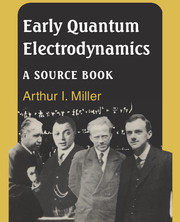Book contents
- Frontmatter
- Contents
- Preface
- Notes to the Preface
- Acknowledgements
- Notes to the Reader
- I Frame-setting essay
- Epilogue
- Notes
- References to the Frame-setting essay
- II Selected papers
- 1 The self-energy of the electron
- 2 Remarks on radiation theory
- 3 Theory of the positron
- 4 Discussion of the infinite distribution of electrons in the theory of the positron
- 5 The self-energy of the electron
- 6 Remarks on the Dirac theory of the positron
- 7 The quantization of the scalar relativistic wave equation
- 8 The electrodynamics of the vacuum based on the quantum theory of the electron
- 9 Theory of the emission of long-wave light quanta
- 10 The universal length appearing in the theory of elementary particles
- 11 The interaction between charged particles and the radiation field
- Index to Frame-setting essay
8 - The electrodynamics of the vacuum based on the quantum theory of the electron
Published online by Cambridge University Press: 05 August 2012
- Frontmatter
- Contents
- Preface
- Notes to the Preface
- Acknowledgements
- Notes to the Reader
- I Frame-setting essay
- Epilogue
- Notes
- References to the Frame-setting essay
- II Selected papers
- 1 The self-energy of the electron
- 2 Remarks on radiation theory
- 3 Theory of the positron
- 4 Discussion of the infinite distribution of electrons in the theory of the positron
- 5 The self-energy of the electron
- 6 Remarks on the Dirac theory of the positron
- 7 The quantization of the scalar relativistic wave equation
- 8 The electrodynamics of the vacuum based on the quantum theory of the electron
- 9 Theory of the emission of long-wave light quanta
- 10 The universal length appearing in the theory of elementary particles
- 11 The interaction between charged particles and the radiation field
- Index to Frame-setting essay
Summary
Mathematisk-Fysiske Meddelelser det Kgl. Danske Videnskabernes Selskab, 14(6): 3–39 (1936).
[Weisskopf's paper was originally printed with the following English-language abstract.]
This paper deals with the modifications introduced into the electrodynamics of the vacuum by Dirac's theory of the positron. The behaviour of the vacuum can be described unambiguously by assuming the existence of an infinite number of electrons occupying the negative energy states, provided that certain well defined effects of these electrons are omitted, but only those to which it is obvious that no physical meaning can be ascribed. The results are identical with these [sic] of Heisenberg's and Dirac's mathematical method of obtaining finite expressions in positron theory. A simple method is given of calculating the polarizability of the vacuum for slowly varying fields.
One of the most important results in the recent development of electron theory is the possibility of converting electromagnetic field energy into matter. For example, a light quantum, in the presence of other electromagnetic fields, can be absorbed in empty space and can be converted into matter. Here, a pair of electrons with opposite charge is created.
If the field where absorption proceeds is static, conservation of energy requires that the absorbed light quantum provides the total energy necessary to create the electron pair. The frequency of the light quantum thus must satisfy the relation hv = 2mc2 + ε1 + ε2, where mc2 is the rest energy of an electron and ε1 and ε2 are the residual energies of the two electrons.
- Type
- Chapter
- Information
- Early Quantum ElectrodynamicsA Sourcebook, pp. 206 - 226Publisher: Cambridge University PressPrint publication year: 1994
- 8
- Cited by



